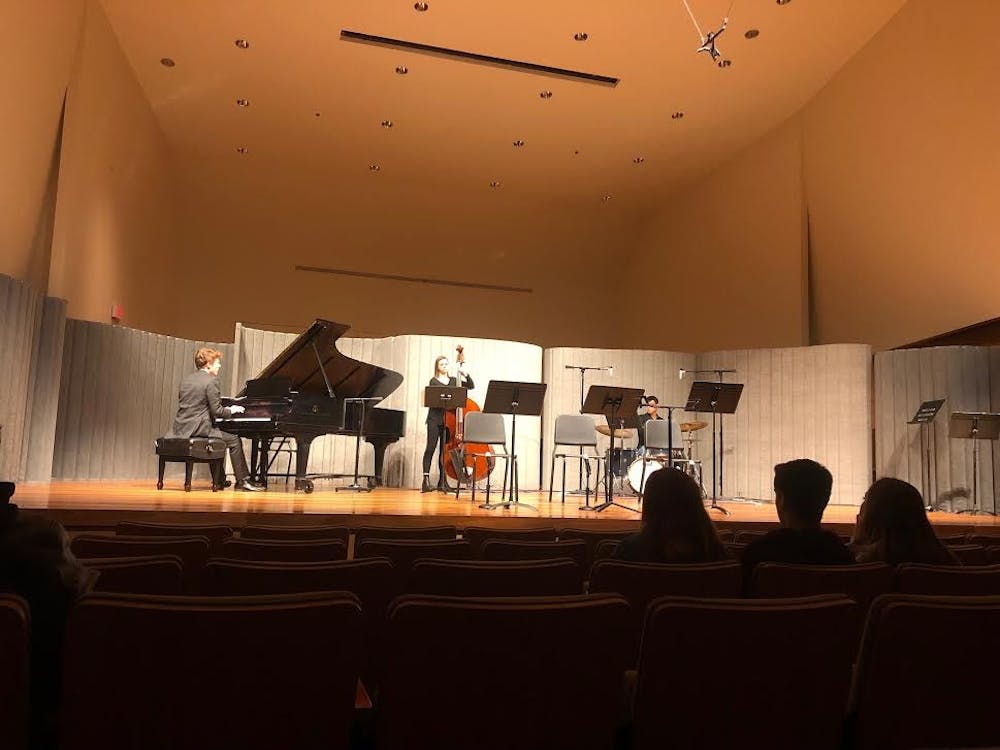On Nov. 16, student musicians, soloists and directors of varying musical backgrounds and specializations came together in Abramson Family Recital Hall to create a cohesive, interconnected performance that embodied not only musical coexistence, but also musical accordance. The American University Workshop: Shared Space showcased a variety of music styles from classical to jazz. Instruments adapted smoothly to its challenging and diverse selection, alternating seamlessly between various time signatures and dynamics.
The workshop opened with Ivan Trevino’s “Shared Space,” a fascinating performance by a seven-member percussion ensemble, including Thomas Anderson, Austin Bartola, Bradley Blecker, Matt Francisco, Tim Madden, Brendan Moriak and Carlo Zahl.
Director Noah Getz explained, “The inspiration for the concert is derived from this concept of shared space,” and the musicians perfectly embodied this treatment of the stage as a communal outlet.
They captivated the audience, actively engaging them with their seamless synchronization. The piece began with a few alternating pitches, but soon expanded to an array of them.
The room became filled with overlapping rhythms and harmonies as students alternated impeccably from upbeat, exciting movements to calmer, tranquil reverberations. At one time, up to five students shared the same keyboard instrument, keeping the audience on its toes as they played, quite literally, in tune with one another.
The second piece, Lee Hyla’s “We Speak Etruscan,” featured a contrasting yet complementary overlapping of melodies by a bass clarinet and baritone saxophone.
Getz described how the piece juxtaposes jazz-like riffs with “monolithic, ancient kinds of sounds,” as well as “indecipherable sections” that resemble the sounds of the ancient language, Etruscan. From its eerie opening with the clashing of two tones so similar you’d think they were the same, to its abrupt escalation of tempo and volume, the two musicians played together in perfect time, truly exploring the stage as a shared space.
Another crowd favorite was Steven Mackey’s “Strange Humors,” a piece whose score itself demonstrates the community of the stage, combining the modality and syncopation of middle Eastern music with percussive African drums. Though originally written for a string quartet and djembe, it has been transcribed to a wind ensemble and saxophone quartet, a change that brought “an entirely new world to this piece,” according to Getz.
As an alluring saxophone melody gradually intensified with the addition of percussive beats and reverberating harmonies that filled the recital hall, the performance enlightened the audience with a glimpse into an entirely new world of musical balance and blend. The piece’s transcription to wind ensemble and saxophone quartet added a richer, fuller sound, playing into the score’s jazzier elements. The wind ensemble, saxophone and percussion added a distinct element to the overall sound quality, yet together, they kept a precise tempo and tone, allowing the overlapping patterns and drum beats to never overpower one another, but create sound cooperatively.
The students’ performance of the second movement, “Pure Happenchance” of Joel Friedman’s “Elastic Band,” achieved a different kind of balance: a delicate dance between sharp, percussive rhythms and enchanting melodies. Friedman, who was an audience member at this performance, wanted “all three music worlds to co-exist and co-mingle within the piece.”
He described to the audience how he interlaced techniques from the classical, twentieth century and pop music worlds. While the violinists’ pitch slides provided a rich texture to the sound, the percussive drumbeat and cymbal crashes added elements of suspense and surprise. It was a euphonic explosion of sound with subsequent patterns that varied just slightly from one another, creating an impression of evolution as the piece alternated between music worlds.
The final three pieces rounded out the students’ repertoire even further. Billy Strayhorn’s “Isfahan” highlighted musicians’ clear tone within their sweet, honeyed sound, as they created harmonies that the recital hall practically absorbed. Benny Golson’s “Are You Real” linked intricate piano riffs with bouncy bass patterns and energetic drum beats, and each musician added a distinct color and dimension to the overall sound without overpowering one another. They concluded the concert with Chick Corea’s “Armando’s Rhumba,” in which students mastered the perfect balance between rich resonance and upbeat percussion, alternating between complex harmonic patterns and moments in which the drum shined.
Overall, I was utterly enthralled throughout the entire performance. I was not alone in my fascination: the audience alternated between being mesmerized and deeply moved throughout the concert. The workshop’s emphasis on cooperation across instruments, styles and genres not only pushed musicians to grasp the intricacies of their sound as a collective, but also enlightened audience members with a newfound appreciation of the interconnected, multifaceted nature of an ensemble’s sound that is too often glossed over.
Acknowledgement of the stage as a shared space truly deepened the performance’s balance and blend, enhancing musicians’ already sophisticated personal musical development within an ensemble. Perhaps we could all take a page from their music books and learn to share space in this world together.





